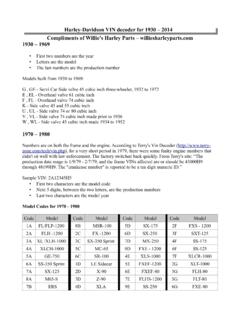Transcription of 3.Consumer Problem 3 - Columbia University
1 3/1/20161 Intermediate Microeconomics W3211 Lecture 3:Preferences and ChoiceColumbia University , Spring 2016 Mark Dean: Story So So far, we have described consumer choice as constrained a consumption ORDER TO TOthe budget constraint And spent some time talking about how one can represent preferences Indifference curves MRS Utility function3 Today s our tools to describe various different types of preferences Standard preferences Monotonic Convex Introduce some other handy classes of preferences Perfect substitutes Perfect compliments Cobb Douglas Varian Ch.
2 3 & 4, Feldman and Serrano Ch 24A Short Diversion: Proofs In your homework, you are asked to prove something In class I claimed that two utility functions u and v represent the same preferences if and only if there is a strictly increasing function f such that u(x)=f(v(x)) for all x. I would like you to prove half of this statement: if there is such a function f, then u and v represent the same preferences Proving things often gets people confused. While they are not central to the course, I will expect you to be able to complete simple proofs This is not because I am mean spirited, but because this type of thinking is important Both in economics and beyond If you are worried about this, make use of office hours Talk to the TAs (or me) sooner rather than later5A Short Diversion.
3 Proofs A proof is basically just a sequence of statements which follow from each other If X then Y If Y then Z These statements don t necessarily need to be mathematical , but maths can be an easy way to make your argument There are many types of proof, but two will be particularly useful for the course Direct: If you are trying to prove that X implies Y prove a sequence of steps X implies A A implies B .. H implies Y By Contradiction: If you are trying to prove that X implies Y, show that assuming X and not Y leads to a contradiction 63/1/20162A Short Diversion: Proofs In most cases, the proofs that you will be required to do just require manipulating the Short Diversion: Proofs An example (from last lecture): A non transitive preference relation cannot have a utility representation.
4 Start by remembering the definitions: Transitivity: , implies Utility representation: there is a function u such that if and only if for all x and y Proof by contradiction: assume that preferences are not transitive, but there IS a utility preferences are non transitive, then there is some x,y and z such that , but NOT there is a utility representation then implies implies This implies that But if this is a utility representation, this implies Contradiction8 Different Types of PreferencesDefining Standard Preferences9 Different Types of Preference We now have two tools to represent preferences Utility functions Indifference curves (and MRS)
5 We are going to use them to think about various different types of preferences To start with we are going to think about what we will call standard preference This adds two assumptions to the ones that we have already made: that preferences Preferences Monotonic preferences are ones in which having more is always better Two types of monotonicity Weak monotonicity: if bundle x has more of every good than bundle y then x is strictly preferred to y for every i implies Strict monotonicity: if bundle x has more of at least one good and no less of any good than bundle y then x is strictly preferred to y for every I and for some i implies Why might monotonicity fail?
6 Bads Satiation11 Monotonic Preferences What do the indifference curves of monotonic preferences look like?123/1/20163 Monotonic Indifference CurvesGood 2 Good 1 Two goodsa negatively sloped indifference Monotonic Indifference CurvesGood 2 Bad 1 One good and onebad a positively sloped indifference amount of good 2 can compensate for Bad 114 Satiation Another example of non-monotonicpreferences For some goods there is a perfect optimal amount Examples Salt in a dish Anchovies on pizza Classes of Intermediate Microeconomics Sometimes there is a bundlethat is the optimal one Called satiation/bliss point15 Indifference Curves Exhibiting
7 Satiationx2x1 Satiation(bliss)point16 Indifference Curves Exhibiting Satiationx2x1 BetterSatiation(bliss)point17 Indifference Curves Exhibiting Satiationx2x1 BetterSatiation(bliss)point183/1/20164 Monotonic Preferences What do the indifference curves of monotonic preferences look like? Downward sloping Weakly monotonic can be horizontal or vertical Strictly monotonic strictly downward sloping What does the MRS of monotonic preferences look like Positive (as it is the negative of the slope of the indifference curve) Weakly monotonic can be 0 or infinity Strictly monotonic strictly positive real number What do monotonic utility functions look like?
8 Marginal utility is always positive: 0for every i: strictly monotonic 0for every i and 0some i : weakly monotonic 19 Convexity Convexity: Roughly speaking - mixtures of bundles are preferred to the bundles themselves. , say that the consumer is indifferent between x and y the 50-50 mixture of the bundles x and y isz = ( )x + ( )yThen: convexity says that z is at least as preferred as x or y What does a mixture mean? The average of the number of each good given by the two bundles 1 1 1 20 Convexity Again, two flavors of convexity: Weakly convex: If x is indifferent to y, then any mixture of x and y is weaklypreferred to either implies 1 Strictly convex: If x is indifferent to y, then any mixture of x and y is strictly preferred to either implies 1 21 Interpretation of Convexity Why are we assuming convexity?
9 Does it make sense? Well, think about constructing a meal Say you were indifferent between 2lb of mash potato (and no steaks) or 2 steaks (and no mash potato) It is likely that you would prefer 1lb of mash potato and 1 steak to either bundle Can think of many similar examples Holidays and cars Visits to the dentist and visits to the theatre Economics classes and novels What about ice cream and crab paste? Arguably still yes Depends on whether we think that these things are consumed at exactly the same time 22 Convexity What do the indifference curves of convex preferences look like?
10 23 Graphically: Convexityx2y2x2+y22x1y1x1+ + implies that the set of weakly preferred bundles is a convex set Indifference curve is convex243/1/20165 Strict Convexityx2y2x1y1xyPreferences are strictlyconvexwhen allmixtures z are strictlypreferredto original bundles x and yz25 Weak y z Preferences are weakly convexif at least one mixture z is equally preferredto a component bundlexzy26 Non-Convex Preferencesx2y2x1y1zThe mixture zis less preferredthan x or Non-Convex Preferencesx2y2x1y1zThe mixture zis less preferredthan x or What do the indifference curves of

















